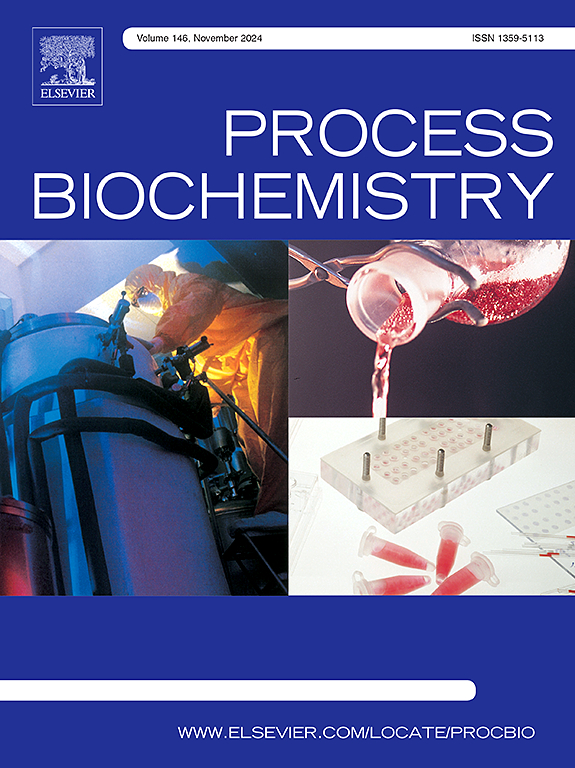设计盐诱导聚合物-聚合物双相体系,优化提取木糖基培养基发酵获得的红曲橡胶生物色素
IF 4
3区 生物学
Q2 BIOCHEMISTRY & MOLECULAR BIOLOGY
引用次数: 0
摘要
合成色素的广泛使用引发了对生物安全和环境的担忧,突出了对红曲霉生物色素等天然替代品的需求。这些色素具有抗菌和抗氧化特性,具有生物技术和生物制药的潜力。利用木质纤维素生物质中富含木糖的水解物生产具有成本效益的生物色素已经被探索,但其可持续的下游加工是至关重要的。传统的液液萃取挥发性有机化合物(VOCs)是有害的,因此基于绿色化学原理的生态友好型双相水萃取系统(ABS)应运而生。本研究利用聚乙二醇(PEG)、聚丙烯酸钠(NaPA)和盐(MgSO4和CaCl2)组成的ABS,研究了发酵液中红曲霉橡胶生物色素(黄色、橙色和红色)的稳定性、分配和纯化。双节点曲线显示MgSO4比CaCl2更有效地促进了相分离。生物色素在65天内表现出高稳定性,并优先分配到富含peg的阶段(KBiopigments = 3-14),回收率(RECTop)值为52-79 %。最佳ABS条件(18 % wt/wt PEG8000, 10 % wt/wt NaPA1200和0.3 M MgSO4)产生的生物色素RECTop为71 - 80% %,KBiopigments为12 - 15%,对蛋白质有很高的选择性(S = 14-19)。蛋白质污染物主要进入富含napa的阶段,达到10倍的纯化。这些发现为生物色素的稳定和环保提取提供了生物工业应用的支持。本文章由计算机程序翻译,如有差异,请以英文原文为准。
Designing salt-induced polymer-polymer biphasic systems for optimized extraction of Monascus ruber biopigments obtained by fermentation of xylose-based medium
The widespread use of synthetic colorants raises biosafety and environmental concerns, highlighting the need for natural alternatives like Monascus biopigments. These pigments possess antimicrobial and antioxidant properties, offering biotechnological and biopharmaceutical potential. Cost-effective biopigment production using xylose-rich hydrolysates from lignocellulosic biomass has been explored, but its sustainable downstream processing is crucial. Traditional liquid-liquid extraction with volatile organic compounds (VOCs) is harmful, prompting the use of eco-friendly aqueous biphasic systems (ABS) based on green chemistry principles. This study investigated the stability, partitioning, and purification of Monascus ruber biopigments (yellow, orange, and red) from fermented broth using ABS composed of polyethylene glycol (PEG), sodium polyacrylate (NaPA), and salts (MgSO4 and CaCl2). Binodal curves showed MgSO4 enhanced phase separation more effectively than CaCl2. Biopigments demonstrated high stability over 65 days and preferentially partitioned into the PEG-rich phase (KBiopigments = 3–14), with recovery (RECTop) values of 52–79 %. Optimal ABS conditions (18 % wt/wt PEG8000, 10 % wt/wt NaPA1200, and 0.3 M MgSO4) yielded biopigment RECTop of 71–80 %, KBiopigments of 12–15, and high selectivity over proteins (S = 14–19). Protein contaminants predominantly partitioned into the NaPA-rich phase, achieving a 10-fold purification. These findings support the stabilization and eco-friendly extraction of biopigments for bio-industrial applications.
求助全文
通过发布文献求助,成功后即可免费获取论文全文。
去求助
来源期刊

Process Biochemistry
生物-工程:化工
CiteScore
8.30
自引率
4.50%
发文量
374
审稿时长
53 days
期刊介绍:
Process Biochemistry is an application-orientated research journal devoted to reporting advances with originality and novelty, in the science and technology of the processes involving bioactive molecules and living organisms. These processes concern the production of useful metabolites or materials, or the removal of toxic compounds using tools and methods of current biology and engineering. Its main areas of interest include novel bioprocesses and enabling technologies (such as nanobiotechnology, tissue engineering, directed evolution, metabolic engineering, systems biology, and synthetic biology) applicable in food (nutraceutical), healthcare (medical, pharmaceutical, cosmetic), energy (biofuels), environmental, and biorefinery industries and their underlying biological and engineering principles.
 求助内容:
求助内容: 应助结果提醒方式:
应助结果提醒方式:


